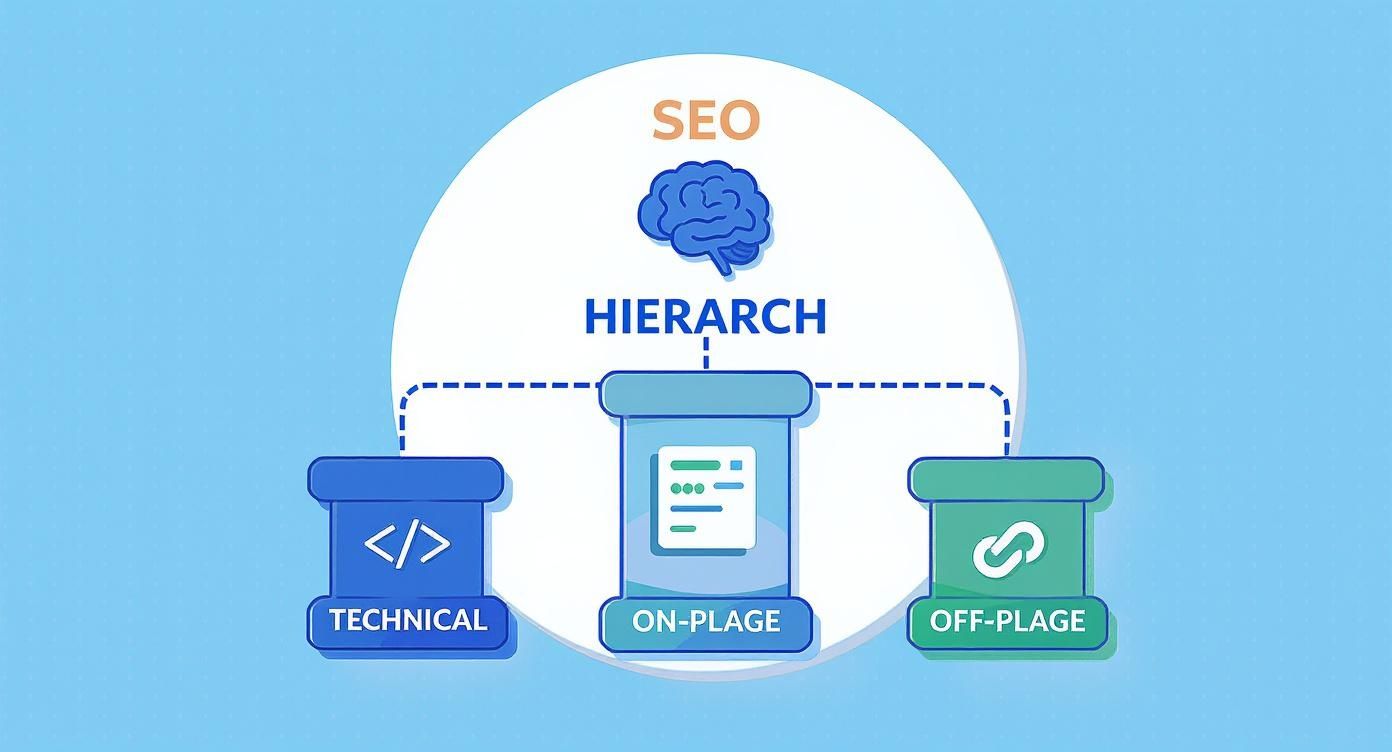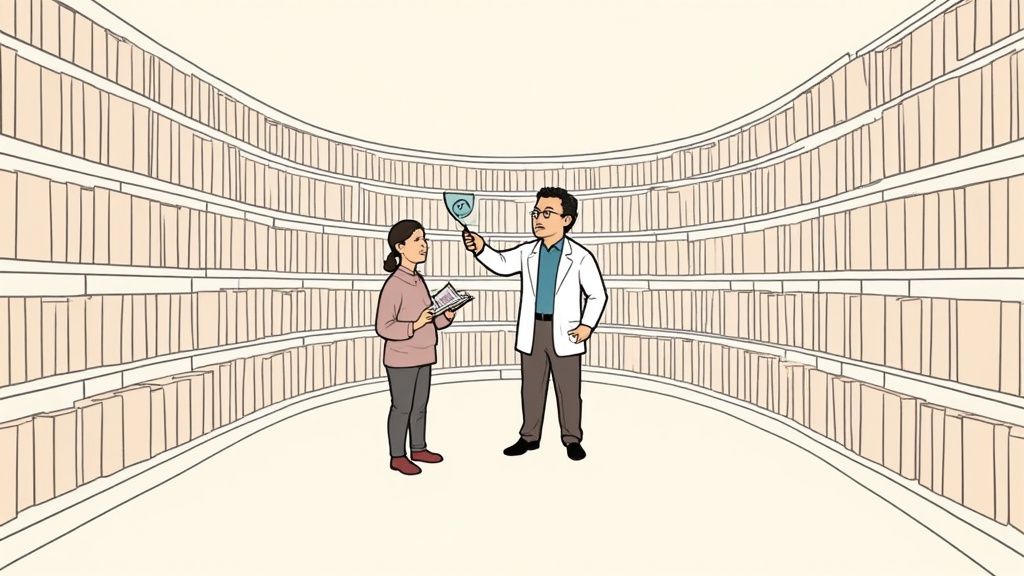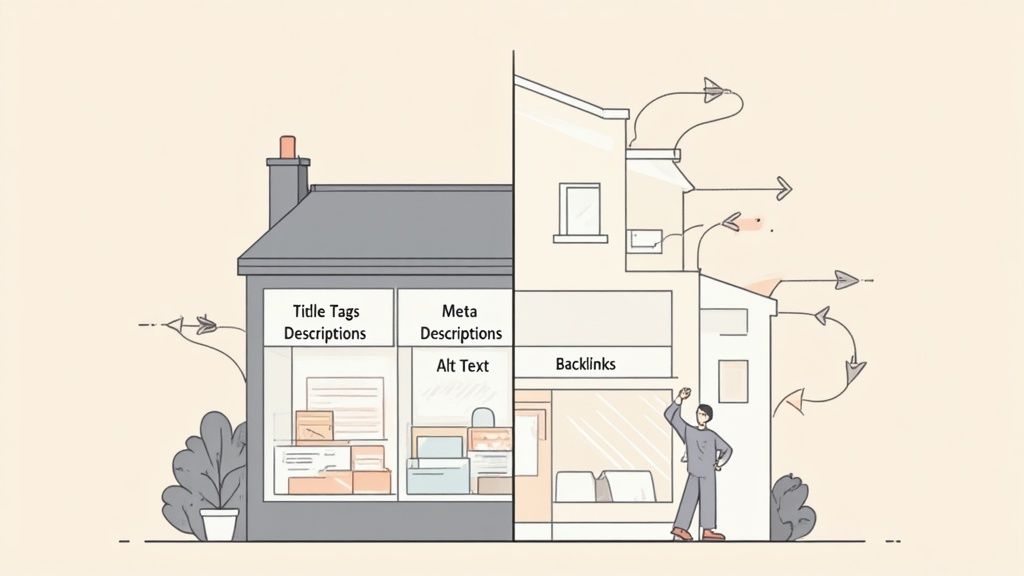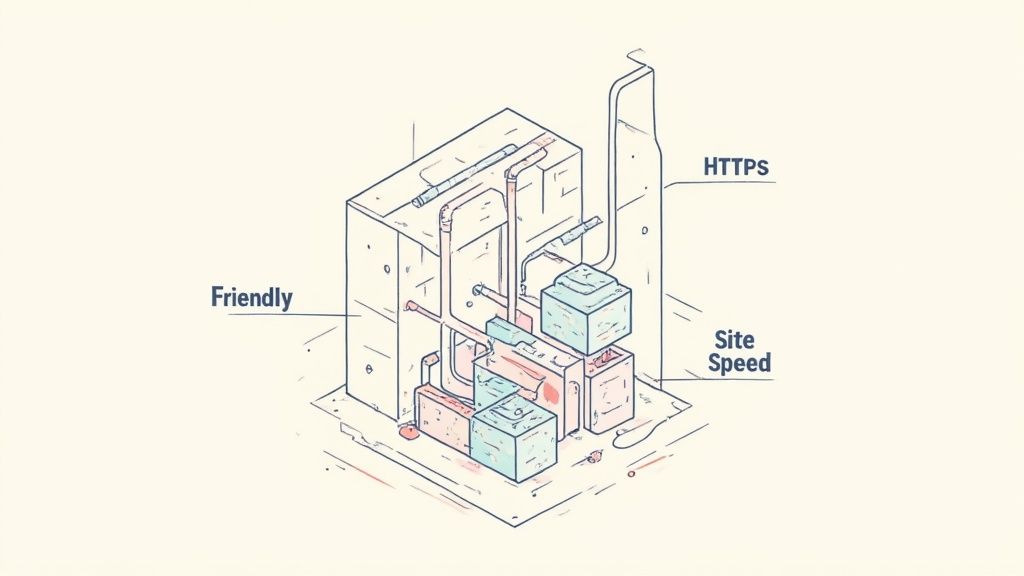What Is Search Engine Optimization for SaaS?
Search engine optimization (SEO) is the art and science of making your website more visible when people look for what you offer on search engines like Google.
Think of it this way: your goal is to show up as the most helpful and credible answer when someone asks a question. Get it right, and you’ll land at the top of the search results.
Understanding Search Engine Optimization
Imagine the internet is a massive, ever-expanding library, and Google is the world’s smartest librarian.
When someone types a search query like "best project management software," the librarian instantly scans billions of books (your website and your competitors' sites) to find the most relevant one. So, what is search engine optimization in this scenario? It’s how you design, write, and label your book so the librarian knows it’s the absolute best, most authoritative answer on the shelf.
At its core, SEO involves a series of improvements to your website that help search engines better understand its purpose and content. The main goal is to rank higher on the search engine results page (SERP) for the keywords your customers are using. This isn’t about tricking algorithms; it’s about providing genuine, undeniable value to real people.
When done right, this process tells search engines that your SaaS landing page is the ideal solution to a user’s problem, earning you a steady stream of valuable organic (non-paid) traffic. The potential here is huge—over 53% of all website traffic comes from organic search, blowing paid ads out of the water.
Even better, the top five organic results scoop up about two-thirds of all clicks. That makes a high ranking absolutely critical for getting noticed.
To get there, you need to master the three core pillars of SEO. This simple table breaks down how they work together.
SEO at a Glance: The Three Core Pillars
| Pillar | Primary Goal | Key Activities |
|---|---|---|
| Technical SEO | Ensure your site is fast, secure, and easy for search engines to crawl and index. | Site speed optimization, mobile-friendliness, XML sitemaps, and secure connections (HTTPS). |
| On-Page SEO | Create relevant, high-quality content that directly answers a user's search query. | Keyword research, content creation, title tags, meta descriptions, and header tags. |
| Off-Page SEO | Build your website's authority and credibility through external signals and references. | Backlink building, guest blogging, social media marketing, and online reviews. |
As you can see, a successful strategy is built on a solid technical base, supported by great content, and amplified by signals of trust from around the web.

This visual shows how it all fits together. A solid strategy depends on a strong technical foundation, valuable on-page content, and authoritative off-page signals all working in harmony.
To make sure your efforts pay off, it’s essential to keep up with the latest 10 SEO optimization best practices. By focusing on these elements, you can systematically improve your website’s performance and attract more qualified leads without paying for every single click.
From Keyword Stuffing to User Intent
 Search engine optimization wasn't always this sophisticated. Back in the early days of the web, SEO was the Wild West. Success was often a matter of who could outsmart the simple, clunky algorithms of the time.
Search engine optimization wasn't always this sophisticated. Back in the early days of the web, SEO was the Wild West. Success was often a matter of who could outsmart the simple, clunky algorithms of the time.
The go-to strategy? Keyword stuffing. You’d just jam your target keyword onto a page as many times as humanly possible, sometimes even hiding it in white text on a white background. It was all about signaling relevance to a search engine, with zero regard for the poor soul who actually had to read the page. Unsurprisingly, this led to a lot of unreadable junk clogging up the search results.
The Shift Toward Quality
Then, everything changed. As search engines like Google got smarter, the game evolved. The term 'search engine optimization' officially popped up in 1997, and just a year later, Google rolled out its PageRank algorithm. This was a seismic shift.
Suddenly, factors like backlinks started to matter more than just keyword density. Over the years, major updates began actively penalizing sites that were trying to cheat the system. The old bag of tricks was dead.
This history lesson reveals a core truth for anyone doing SEO today: trying to "trick" an algorithm is a short-term, losing battle. A search engine's goal is to deliver the best possible answer to a user's question. So, the only sustainable SEO strategy is to align your content with that exact same goal.
The secret to modern SEO isn't about gaming the system. It's about creating such a valuable and seamless user experience that search engines have no choice but to recognize you as the best result.
From Keywords to People
Today, the entire conversation has shifted from just keywords to a much deeper concept: user intent. It’s all about understanding the why behind the search.
What is someone really trying to do when they type something into Google? Are they in research mode? Are they comparing their options? Or are they ready to pull out their credit card? Nailing the answer to that question is the bedrock of modern SEO. To do it well, you need a deep understanding of your audience, which you can get by learning how to create buyer personas for your business.
When you focus on user intent, you naturally create content that is more helpful, relevant, and trustworthy. This doesn't just make search engines happy; it builds a real connection with potential customers, turning casual searchers into loyal users. This shift—from manipulation to genuine value—is what defines successful SEO today.
Building Your Digital Presence On-Page and Off-Page SEO
To really get what search engine optimization is, let’s split it into two buckets you’ll be working with constantly: on-page and off-page SEO.
Imagine your website is a brand-new brick-and-mortar store. Everything you do inside that store to make it inviting and easy for customers to find what they need? That's on-page SEO. It's the stuff you have 100% control over.
This means putting up clear, bold signage (your headers), creating well-organized aisles (your site structure), and writing detailed product labels (your actual content and keywords). When you nail these things, you're making it incredibly easy for search engines to understand what each page is about and why it’s valuable to a visitor.
This clarity is critical for search engine crawlers—think of them as robotic shoppers sent to scope out your store. They need to figure out what you're selling and how good it is, fast.
Mastering Your On-Page Elements
The on-page SEO work that delivers the biggest bang for your buck involves tweaking specific parts of your website’s code and content. You don't need to be a developer to handle these, but they are absolutely crucial for telling search engines that your page is relevant to a search.
Key on-page factors include:
- Title Tags: This is the clickable headline that shows up in the search results. It’s your first, and sometimes only, chance to grab a user's attention.
- Meta Descriptions: The little blurb of text under your title tag in the search results. A great description is like ad copy—it can make or break whether someone clicks.
- Image Alt Text: A simple description of an image that helps search engines “see” what it is. This is huge for accessibility and can help you rank in image searches.
- Header Tags (H1, H2, H3): These are like the chapter titles and subheadings in a book. They give your content structure, making it much easier for both people and search engines to digest.
By dialing in these elements, you’re basically decorating your storefront and organizing your aisles to create a great shopping experience. Search engines notice that and reward you with better visibility.
Earning Trust with Off-Page SEO
Now, let's step outside your store. Off-page SEO is all about your reputation around town. It’s not what you say about yourself, but what other people say about you. In the SEO world, this is built almost entirely through backlinks.
A backlink is just a link from someone else's website pointing to yours. Each one acts as a referral or a "vote of confidence." When a credible, high-authority site links to your page, it’s a powerful signal to Google that your store is trustworthy and worth visiting. In fact, one study found that the #1 search result typically has 3.8 times more backlinks than the results in positions 2-10.
Think of it this way: if a popular local news site writes an article raving about your business, more people are going to trust that recommendation and stop by. Backlinks do the exact same thing online, building your website’s authority and credibility.
These external signals are so important because they're hard to get and even harder to fake. You can’t just buy a great reputation; you have to earn it by creating something so valuable that other people genuinely want to share it. This is one of the most powerful ways to increase website traffic for the long haul.
When you combine strong on-page optimization with a solid off-page reputation, you've got a killer one-two punch for climbing the search rankings.
Strengthening Your Website's Foundation with Technical SEO
 If on-page SEO is your storefront and off-page SEO is your reputation around town, then technical SEO is the very foundation of the building. It’s the plumbing, the wiring, the structural integrity. It doesn't matter how great your products or content are if the doors won't open or the lights keep flickering. People will just leave.
If on-page SEO is your storefront and off-page SEO is your reputation around town, then technical SEO is the very foundation of the building. It’s the plumbing, the wiring, the structural integrity. It doesn't matter how great your products or content are if the doors won't open or the lights keep flickering. People will just leave.
Technical SEO is all the behind-the-scenes work that makes your site easy for search engines to find, understand (crawl), and organize (index). It’s less about the words on the page and more about how the page is actually built. For a SaaS business, a flawless technical setup isn't just nice to have—it's the price of entry for a smooth user experience that can earn top rankings.
Without a solid technical base, even the most brilliant content or backlink strategy will fall flat. It’s the invisible force that lets all your other SEO efforts shine.
Making Your Site Accessible to Search Engines
First things first, you need to make sure search engine crawlers can actually navigate your website without hitting dead ends. The main tool for this job is your XML sitemap. Think of it as a blueprint of your entire site that you hand directly to Google. It lists all your important pages, making sure nothing gets missed.
Site structure is the other piece of this puzzle. A logical, well-organized website helps crawlers understand the relationships between your pages and what content you consider most important. This ensures they can discover your most valuable landing pages quickly and efficiently.
Prioritizing Speed and Security
In a world of instant gratification, speed is everything. Google has been very clear that page speed is a direct ranking factor for both desktop and mobile. Users expect pages to load in the blink of an eye. A slow site leads to high bounce rates and frustrated visitors, which screams "bad user experience" to search engines.
A one-second delay in page load time can result in a 7% reduction in conversions. For a SaaS business, that’s not just a statistic—it’s lost sign-ups and real money left on the table.
Security is just as critical. Having a secure connection, shown by the HTTPS in your URL, is another confirmed ranking signal. It encrypts the data between a user's browser and your server, keeping their information safe. Search engines like Google actively prioritize secure websites to protect their users, and modern browsers will often warn people before they even enter a non-secure site.
A fast, secure, and easily crawlable site is the bedrock of any successful SEO strategy. These core technical elements build trust with both users and search engines, paving the way for higher rankings and more organic traffic.
Creating Content That Ranks and Converts

Think of content as the fuel that powers your entire SEO machine. But great SEO isn't just about stuffing keywords onto a page and calling it a day. The real goal is to create genuinely valuable content that solves a real problem for your audience—and in doing so, clearly signals its purpose to search engines.
At the absolute core of this is search intent, which is just a fancy way of asking why someone typed a query into Google in the first place. Nailing this is the difference between attracting random traffic and attracting actual customers. Are they just browsing for information? Are they comparing different tools? Or are they ready to pull out their credit card right now? Your SaaS landing page has to meet them exactly where they are.
Uncovering Customer Needs with Keyword Research
Let's be clear: effective keyword research isn't about finding obscure, low-competition terms to game the system. It's about discovering the exact language your customers use when they're talking about their problems. This process is a goldmine, revealing their biggest questions, frustrations, and goals.
You’re essentially doing a bit of digital eavesdropping. By seeing what people are actually searching for, you get a direct line into their mindset. This lets you craft your landing page to be the perfect, tailor-made solution they’ve been looking for. This insight is what turns a generic page into a conversion machine.
The most powerful content doesn't just rank for a keyword—it comprehensively answers the question that the keyword represents. It addresses the user's underlying problem so thoroughly that they have no need to go back to the search results.
This approach means going beyond the basic keyword tools. You need to map specific keywords to the different stages of the buyer's journey. This ensures you’re creating the right message for the right person at precisely the right time.
Structuring Content for Humans and Search Engines
Once you know what to write about, how you write it becomes just as critical. Nobody wants to be greeted by a massive wall of text. It's intimidating. Structuring your content for easy reading is crucial for keeping people engaged and signaling quality to search engines.
Here are a few simple, non-negotiable best practices:
- Use Clear Headings: Break up your text with descriptive H2 and H3 subheadings. This helps readers scan the page and immediately find the section that matters most to them.
- Keep Paragraphs Short: Stick to one main idea per paragraph, and try to keep them to 2-3 sentences. This creates valuable white space and makes your content feel way more approachable.
- Incorporate Multimedia: People love visuals. Images, videos, and infographics not only boost engagement but can often explain complex ideas far better than text alone.
At the end of the day, your primary audience is a person, not an algorithm. Write in a natural, conversational tone that connects with your ideal customer. When you focus on creating a great user experience, the rankings tend to follow. To make sure your content is hitting all the right notes, exploring advanced content optimization strategies can give you a serious competitive advantage.
Turning SEO Data Into Actionable Strategy
Getting the basics of SEO down is one thing. Actually turning that knowledge into a repeatable process for growth? That's where the real magic happens. SEO is never a "set it and forget it" task. It’s a living, breathing cycle of measuring what you did, figuring out what it means, and then doing it even better the next time.
To pull this off, you have to be tracking the right stuff. While you can get lost in an ocean of data points, only a handful are truly essential for a SaaS business that wants to scale with organic search.
Measuring What Truly Matters
Focusing on the right numbers is how you cut through the noise and see what’s actually moving the needle. At a minimum, you should be keeping a close eye on these core metrics:
- Organic Traffic: This is the total number of people showing up from search engines. A steady climb here is a great sign your overall visibility is on the rise.
- Keyword Rankings: Where do you stand for the keywords you care about? Tracking this tells you how well you’re competing for valuable search terms.
- Bounce Rate: The percentage of visitors who land on your page and leave without doing anything else. A high bounce rate can be a red flag that your content isn’t matching what the searcher expected.
- Conversion Rate: The percentage of visitors who take the action you want them to, like signing up for a trial. This is the bottom-line metric that proves your SEO is working.
Here’s a look at how a tool like Pages.Report helps you visualize and make sense of your landing page performance.
A good dashboard turns a mess of raw numbers into a clear story. It connects the dots between traffic, engagement, and conversions, so you can stop just observing and start taking strategic action—whether that means a few content tweaks or a deeper technical fix.
SEO is a long-game investment. The only way to prove its value is by tracking its impact on your bottom line. You have to tie your efforts directly to business goals like leads, trial sign-ups, and actual revenue.
By consistently digging into your performance data, you can build a powerful, data-driven strategy that just keeps getting smarter. For a deeper look at this, check out our guide on how to measure marketing ROI to connect your SEO work to real business growth.
Common Questions About Search Engine Optimization
Stepping into the world of SEO can feel a bit like drinking from a firehose. A lot of information comes at you fast, and it’s natural to have questions. Let’s clear the air and tackle some of the most common ones I hear all the time.
One of the first things everyone wants to know is, "How long does this SEO stuff actually take to work?" The honest-to-goodness answer is, it depends. But you need to be in it for the long haul. You’ll probably start to see some initial movement in three to six months, but the real, meaningful results often take closer to a year to show up. SEO is an investment, not a magic button.
Another big point of confusion is the difference between SEO and paid search (PPC). I like to think of it as owning versus renting. With SEO, you’re building equity in a valuable asset—your organic ranking—that keeps paying you back over time. With PPC, you’re just renting the top spot. The second you stop paying, the traffic disappears.
How Often Do I Need to Do SEO?
Lots of people wonder if SEO is a one-and-done kind of deal. Far from it. Search engine optimization is a continuous, living process. Google’s algorithms are always changing, your competitors are constantly trying to one-up you, and new keywords are always popping up.
Effective SEO isn’t a project with a start and end date; it's a constant cycle of monitoring what’s working, analyzing the data, and tweaking your strategy to stay ahead of the curve. You have to keep feeding the machine with fresh content and regular technical check-ups to maintain your momentum.
Finally, a common worry is whether you need to be some kind of coding genius. While the technical side of SEO is definitely important, you don’t need to be a developer to make a huge impact. So much of it comes down to smart marketing and good communication—things like creating genuinely helpful content and building relationships to earn backlinks. Starting with these fundamentals can get you incredibly far.
Ready to turn SEO insights into a high-converting landing page? Pages.Report gives you access to proven patterns from over 368 successful SaaS products. Start improving your landing page today.
